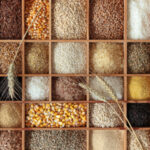Key Facts
- Grains are an important source of carbohydrates.
- Whole grains contain nutrients from all parts of the grain.
- Grains provide vitamins, minerals, fiber, and energy to your brain and muscles.
Foods such as wheat, rice, oats, cornmeal, barley, quinoa or products made from these ingredients are considered grains. Grains are high in carbohydrates which provide energy to your brain and muscles. The health benefits of a grain depend on the form of the grain you eat. There are two types of grains: whole grains and refined grains. A whole grain is a food item that contains the entirety of the grain as it was harvested. Whole grains contain a wide variety of nutrients and fiber because no part of the grain is removed so you’re getting nutrients from all parts of the grain. Whole grain foods include oatmeal, brown rice, quinoa, and whole wheat bread or pasta. Refined grains have been processed, which removes some parts of the grain. Because of this processing, many of the nutrients you would get from a whole grain are missing. Refined grain foods include white bread, white rice, and most pastas. When you eat grains or grain products, aim for at least 50% from whole grain sources.
What are some different kinds of grains?
There are many different types of great tasting grains. Add variety to your diet by trying some of the grains listed below. These grains can be added to stews, soups, or salads, served as a side dish, or eaten as a hot cereal.
| Amaranth is a whole grain that looks like tiny yellow seeds. You can use it to make hot cereal or add it to whole-grain baked goods for extra crunch and fiber. | 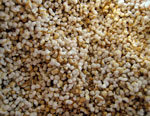 |
| Barley is a large, brown grain. You can find it in stores sold either as “pearled” or “hulled” (also called hulless). Hulled barley is a whole grain and has more vitamins, minerals, and fiber. Pearled barley is not a whole grain, because it is processed, so it is missing some nutrients. However, it is still a great option compared to other types of refined, processed grains because it contains fiber. Barley can be added to soups, stews, hot cereals, and casseroles. You can also try adding barley to salads or stuffing. | 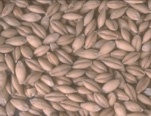 |
| Buckwheat is a reddish-brown plant seed, which can be eaten whole, cracked (broken), hulled, or toasted. Kasha is made from buckwheat and can be used in pilafs, burgers, or in casseroles. | 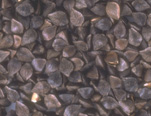 |
| Bulgur is a made from whole wheat kernels. It is found in many Middle Eastern dishes, such as tabbouleh. Because it cooks quickly, it is a great grain for people new to whole grain cooking. | 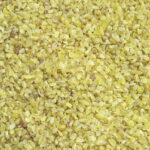 |
| Corn is a grain that grows on a cob with the kernels enclosed in a leafy husk. Corn can be eaten whole or ground into cornmeal, which can be made into foods such as bread or tortillas. Corn is a whole grain (unless the label says “degerminated”). Many people are surprised to learn that popcorn is a whole grain. | 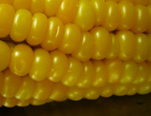 |
| Farro is an ancient grain that has a nutty flavor and looks similar to barley. It can be eaten in salads, soups, stews, and pilafs. It contains protein and fiber, and is packed with vitamins, minerals, and antioxidants. When possible, choose whole grain farro over pearled. | 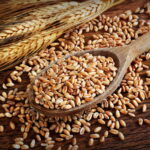 |
| Millet is a small, yellow, and bead-like whole grain. Millet has a mild, nutty flavor and can be eaten in salads, pilafs, or mixed with pasta. | 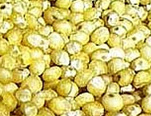 |
| Quinoa (pronounced keen-wa) is a small, disk-shaped seed either yellow or red in color with a light flavor and texture. Quinoa is a great source of protein and can be cooked and used in salads, soups, stews, and pilafs. | 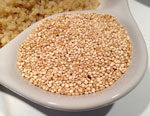 |
| Rice comes in many different varieties and is popular worldwide. Brown rice is a whole grain and contains more vitamins, minerals, and fiber than white rice. White rice has the outer part of the grain removed and therefore is not a whole grain. When cooked, long-grain rice is fluffier while short-grain rice is stickier. | 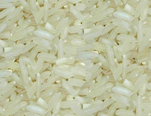 |
| Teff is a very small brown grain the size of a poppy seed which is native to Africa. It has a somewhat nutty flavor and is high in minerals such as iron. |  |
| Wheat is a commonly eaten grain that comes in different forms. Whole wheat kernels (such as bulgur and wheat berries) can be eaten on their own as a side dish or in a salad. Look for versions of these products that contain “whole wheat”. | 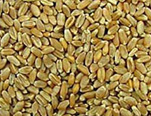 |
| Nutrition Facts for Grains | |
| 1/2 Cup Serving (cooked) | Fiber |
| Amaranth | 2.6 grams |
| Barley, hulled, cooked | 5 grams |
| Barley, pearled | 3 grams |
| Brown Rice | 2 grams |
| Buckwheat | 2.3 grams |
| Bulgur | 4 grams |
| Corn | 2 grams |
| Farro | 3.5 grams |
| Millet | 1 grams |
| Teff | 3.5 grams |
| Quinoa | 2.6 grams |
| White Rice | 0.3 grams |
How do I cook grains?
Often grains are found in food items you use every day such as bread and pasta. The grains listed above can be cooked and eaten on their own. Some require that you rinse them in cold water and then drain prior to cooking. Most grains are cooked by putting ~2 cups of cold water in a pot and bringing to a boil, then adding ~1 cup of rinsed grains to the boiling water and covering the pot. Then turn the heat down so the water is boiling lightly, also known as “simmering.” Once there is no water left and grains are slightly chewy, you are done! With this method it is important not to stir or uncover the pot while the grains are cooking. Be sure to follow the directions on the package for whichever grain you are cooking, because different grains will have different cooking times and methods.
Cooking tips:
- Rinse grains prior to cooking to remove any dirt or debris.
- Whole grains take longer to cook than refined grains. For example, brown rice takes about 45 minutes to cook, but white rice only takes about 20 minutes. However, the nutritional benefits are worth the extra cook time!
Here are two easy recipes to try:
Our health guides are developed through a systematic, rigorous process to ensure accuracy, reliability, and trustworthiness. Written and reviewed by experienced healthcare clinicians from Boston Children's Hospital, a Harvard Medical School teaching hospital and consistently ranked as a top hospital by Newsweek and U.S. News & World Report, these guides combine clinical expertise, specialized knowledge, and evidence-based medicine. We also incorporate research and best practices from authoritative sources such as the CDC, NIH, PubMed, top medical journals, and UpToDate.com. Clinical specialists and subject matter experts review and edit each guide, reinforcing our commitment to high-quality, factual, scientifically accurate health information for young people.


